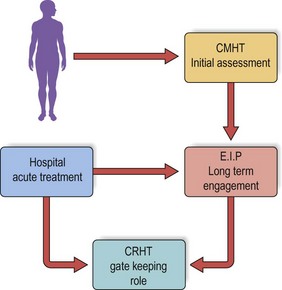Mental health services II
Figure 1 illustrates the pathway through four different mental health teams taken by Sam, a 19-year-old man. Sam presents to his GP for the first time, at the insistence of his mother who is concerned that he is spending all of his time in his bedroom, not seeing his friends, and tending to sleep all day, and stay awake all night. The GP is concerned that he may be depressed and refers him to the Community Mental Health Team (CMHT). He is seen initially by a social worker from the team, who visits him at home. He tells the social worker that he is spending most of his time on his computer because he has discovered a conspiracy that involves police forces in several countries working together to support terrorist activity. He is concerned that as he knows about it he will himself become a terrorist target, and feels he needs to lie low. He is very frightened and distressed by these beliefs, but has not discussed them with anyone else. The social worker is concerned that he is psychotic, and takes him in to the CMHT team base to see the psychiatrist in clinic for an urgent assessment.
Crisis Resolution and Home Treatment teams (CRHT)
 Gatekeeping inpatient beds – this means that they are the final arbiters of whether a patient can be admitted to an acute inpatient bed. They will consider whether the treatment required can be delivered at home instead of in hospital, and if so will provide the necessary care.
Gatekeeping inpatient beds – this means that they are the final arbiters of whether a patient can be admitted to an acute inpatient bed. They will consider whether the treatment required can be delivered at home instead of in hospital, and if so will provide the necessary care.Stay updated, free articles. Join our Telegram channel

Full access? Get Clinical Tree



